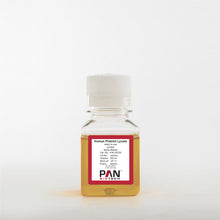Description
Human platelet lysate (hPL) is a xeno-free alternative to FBS. hPL is a promising source of bioactive substances as growth factors not only for in vivo wound healing and tissue repair, but also for the expansion of human cells in culture.
Platelets are a natural source of growth factors. They contain platelet-derived growth factors (PDGFs), basic fibroblast growth factor (bFGF), transforming growth factor (TGF-β), and insulin-like growth factor-1 (IGF-1). Growth factors contain in hPL, like hormones and cytokines lead to a strong proliferation of human cells in culture and also have influence on the cell function. hPL is able to promote mesenchymal stromal cell (MSC) expansion, to decrease the time required to reach confluence and to increase CFU-F size, as compared to the FBS medium. hPL promotes the expansion of human adherent and non-adherent primary cells and cell lines, including primary MSCs.
PAN-Biotech hPL is derived from donor material taken from healthy human volunteers by certified donation institutions in Europe. The collection of blood follows the EU standards (Directive 2002/98/EC - quality and safety standards for the collection, testing, processing, storage and distribution of human blood and blood components).
According to the EU standards, the donors were tested for the following infection parameters: HBsAg, HBV DNA, anti-HCV, HCV RNA, anti-HIV, HIV RNA and Lues serology. It is possible to exclude the window period in case of NAT and antibodies/antigen tests (e.g. HBsAg and HBV NAT) with the current state of the art testing according to EU guidelines.
However, human blood products should always be considered as potentially infectious and handled accordingly. Heat Inactivated or Gamma Irradiated hPL is available on request.
Composition
Defibrinated hPL is made from thrombocytes concentrate. It is a natural product and contains a concentrated mix of thrombocytic growth factors.
Advantages
- Xeno-free alternative to fetal bovine serum (FBS).
- Ready-to-use (defibrinated); no addition of heparin is necessary.
- hPL is not associated with a risk for xenogenic immune reactions or transmission of bovine microorganism and prions.
- Promotes in vitro mesenchymal stem cells (MSCs) expansion.
- Very low batch-to-batch variation.
- Immunophenotype of the stem cells in not influenced by hPL.
- MSCs cultured in the presence of hPL maintain their osteogenic, chondrogenic, and adipogenic differentiation properties.
- No unpredictable stem cell differentiation.
- Reduced cellular senescence after long term cultivation with hPL.
- Heat Inactivated or Gamma Irradiated hPL is available by request.
Specifications
| Species of Origin: | Human |
|---|---|
| Pooled/Single-Donor: | Pooled |
| Ready-To-Use: | Yes. The hPL is completely defibrinated and no addition of heparin is necessary. |
| Endotoxin Content: | Endotoxin content unspecified |
| Filter Pore Size: | 0.2 µm |
| Liquid / Powder: | Liquid |
| Product Category: | Human Serum |
| Product Type: | Human Platelet Lysate (hPL) |
| Size: | 50 ml or 100 ml bottles |
| Sterile: | Yes |
| Storage Temperature: | -20°C |
| Manufacturer: | PAN-Biotech GmbH |
| Country of Origin: | EU Origin |
Application Note
hPL is a human-derived alternative to fetal bovine serum (FBS) in cell culture and can be used for a broad range of different cell types such as human endothelial cells, human fibroblasts, and MSCs from various tissues. We recommend the use of 2.5% - 7.5% hPL. The optimal concentration must be determined for each cell type, cell line, and/or application. As this hPL is already completely defibrinated, no addition of heparin is necessary (ready-to-use).
Figures

Figure 1: hMSC phase contrast pictures were taken with PANsys 3000.

Figure 2: hMSC proliferation: fibroblasts were expanded in presence of hPL or FBS. The figure is showing the average of three independent experiments. Growth conditions: 2000 cells per ml / growth area 1.9 cm^2, medium (DMEM with 4.5 g/L glucose) contains 5% hPL or 10% FBS. The medium was not changed during the growth phase. The cell density was determined after 8 days.

Figure 3: PDFG-BB concentration in hPL: for product characterization, growth factor analysis was performed for PDGF-BB. The figure is showing the average of four independent experiments.

Figure 4: Flow cytometry analysis of positive and negative cell surface antigen expression after cell cultivation with defibrinated hPL. hMSC are identified by the absence of CD45, whereas they are positive for CD44, CD73, CD90, and CD105. Flow cytometry analysis of hMSCs expanded in xeno-free conditions, in 5% hPL for three weeks.
Usage
This product is intended for Laboratory Research Use Only. Not for use in diagnostic or therapeutic procedures. This product may not be used as a pharmaceutical or veterinary drug, agricultural product, or food additive.
Resources
Related Products
- Panexin Serum Replacements
- Human Serum Products
- Human Platelet Lysate (hPL) derived scaffolds & hydrogels
Ilex Life Sciences LLC is an authorized distributor of PAN-Biotech GmbH.




